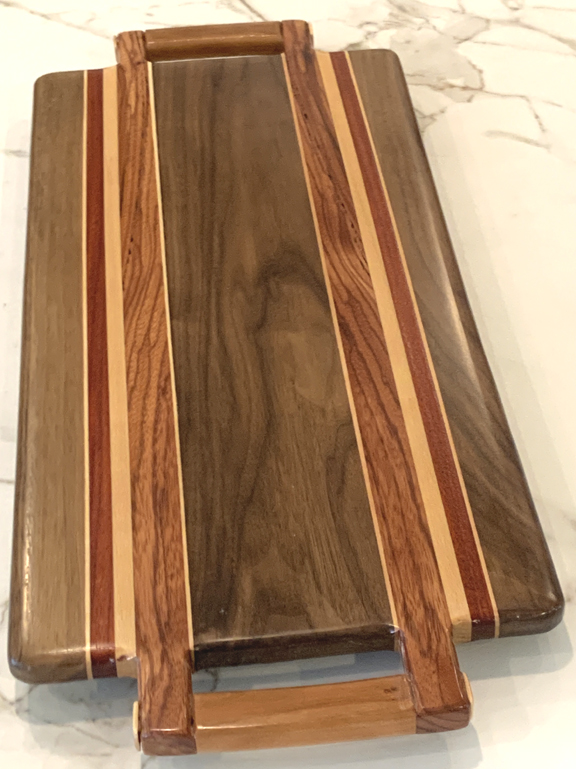

Walnut, Maple, Padauk, and Oak Serving Tray 1201


Measures 24" long by 10" wide by .75" thick - $50
Finished with Mineral Oil
4 Rubber feet on bottom
Oak, White – From Eastern United States. Heartwood is a light to medium brown, commonly with an olive cast. Nearly white to light brown sapwood is not always sharply demarcated from the heartwood. Quartersawn sections display prominent ray fleck patterns. Rated as very durable; frequently used in cabinetry, furniture, interior trim, flooring, boatbuilding, barrels, and veneer.
Walnut, Black – From Eastern United States. Heartwood can range from a lighter pale brown to a dark chocolate brown with darker brown streaks. Color can sometimes have a grey, purple, or reddish cast. Black walnut is important for its attractive timber, which is hard, dense, tight-grained and polishes to a very smooth finish. When kiln-dried, walnut wood tends toward a dull brown color, but when air-dried can become a rich purplish-brown. Because of its color, hardness and grain, it is a prized furniture and carving wood. Veneer sliced from walnut burl is one of the most valuable and highly prized by cabinet makers and prestige car manufacturers. Walnut is also used by makers of stringed instruments such as the violin and guitar and for the body of pipe organs.
Padauk, African – From Central and tropical west Africa. Heartwood color can vary, ranging from a pale pinkish orange to a deep brownish red. Most pieces tend to start reddish orange when freshly cut, darkening substantially over time to a reddish/purplish brown (some lighter pieces age to a grayish brown). Has excellent decay resistance, and is rated as durable to very durable. Padauk is also reported to be resistant to termites and other insects. Common uses are veneer, flooring, turned objects, musical instruments, furniture, tool handles, and other small specialty wood objects. Padauk has a very unique reddish orange coloration, and the wood is sometimes referred to by the name Vermillion. Unfortunately, this dramatic color is inevitably darkened to a deep reddish-brown color. Padauk is moderately heavy, strong, and stiff, with exceptional stability. It's a popular hardwood among hobbyist woodworkers because of its unique color and low cost.
Maple Hard - The Hard Maple Tree is usually referred to as Sugar Maple, and is the tree most often tapped for maple syrup. Sugar Maple's leaves are the shape that most people associate with maple leaves; they typically have either 5 or 7 lobes, with vivid autumn coloring ranging from yellow to purplish red. Its wood is stronger, stiffer, harder, and denser than all the other species of Maple commercially available in lumber form. (It's also the state tree in four different states in the US.) Unlike most other hardwoods, the sapwood of Hard Maple lumber is most commonly used rather than its heartwood. Sapwood color ranges from nearly white, to an off-white cream color, sometimes with a reddish or golden hue. Hard maple is commonly used for flooring (from basketball courts and dance-floors to bowling alleys and residential), paper (pulpwood), making of musical instruments, cutting boards, butcher blocks, workbenches, baseball bats, and other turned objects and specialty wood items.